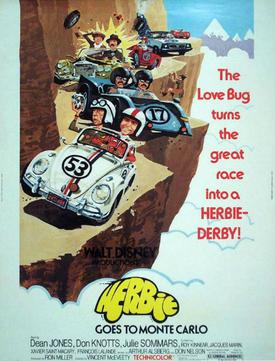
Herbie Goes to Monte Carlo is a 1977 American sports adventure comedy film directed by Vincent McEveety and written by Arthur Alsberg and Don Nelson. The film is the third installment in the Herbie film series and the sequel to Herbie Rides Again (1974). In the film, Dean Jones returns as champion race car driver Jim Douglas, joined this time by his somewhat cynical and eccentric riding mechanic Wheely Applegate. The film follows Douglas, Applegate, and Herbie as they participate in the fictional Trans-France Race, a road race from Paris, France, to Monte Carlo, Monaco.
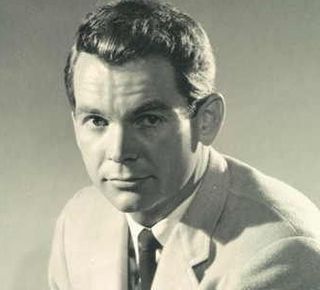
Dean Carroll Jones was an American actor. He was best known for his roles as Agent Zeke Kelso in That Darn Cat! (1965), Jim Douglas in the Herbie franchise (1969–1997), and Dr. Herman Varnick in Beethoven (1992). He was nominated for a Golden Globe Award for his performance as Albert Dooley in The Million Dollar Duck (1971). In 1995, he was inducted as a Disney Legend for his film work.
Walter Edwin Hansgen was an American racecar driver. His motorsport career began as a road racing driver, he made his Grand Prix debut at 41 and he died aged 46, several days after crashing during testing for the 1966 24 Hours of Le Mans.
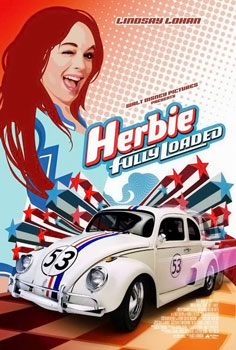
Herbie: Fully Loaded is a 2005 American sports comedy film directed by Angela Robinson from a screenplay by Thomas Lennon, Robert Ben Garant, and Smallville developers Alfred Gough and Miles Millar. The film is the sixth and final installment in the Herbie film series, following the television film The Love Bug (1997), and the first theatrical film since Herbie Goes Bananas (1980). It serves as a direct sequel to the previous films. The film stars Lindsay Lohan, Justin Long, Breckin Meyer, Matt Dillon, and Michael Keaton. It features cameos by many NASCAR drivers, including Jeff Gordon, Jimmie Johnson, Tony Stewart, and Dale Jarrett.

John Rickard Rydell is a retired Swedish racing driver. He won the 1998 British Touring Car Championship, the 2011 Scandinavian Touring Car Championship, and has also been a frontrunner in the European/World Touring Car Championship.

Herbie, the Love Bug is a sentient 1963 Volkswagen Beetle which has been featured in several Walt Disney motion pictures starting with the 1969 feature film The Love Bug. It is the protagonist of all of his movies and has a mind of its own, being capable of driving itself and often becoming a serious contender in auto racing competitions. Throughout most of the franchise, it is distinguished by red, white, and blue racing stripes from the front to the back bumper, a pearl white body, a racing-style number "53" on the front luggage compartment lid, doors, engine lid, and a yellow-on-black 1963 California license plate with the registration "OFP 857".

Herbie Rides Again is a 1974 American comedy film directed by Robert Stevenson from a screenplay by Bill Walsh, based on a story by Gordon Buford. The film is the second installment in the Herbie film series and the sequel to The Love Bug (1968). It stars Helen Hayes, Stefanie Powers, Ken Berry, and Keenan Wynn reprising his villainous role as Alonzo Hawk.

Herbie Goes Bananas is a 1980 American adventure comedy film directed by Vincent McEveety and written by Don Tait. The film is the fourth installment in the Herbie film series and the sequel to Herbie Goes to Monte Carlo (1977).
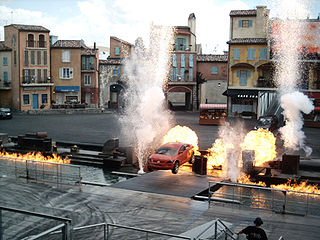
The Lights, Motors, Action!: Extreme Stunt Show, was a stunt show performed at Walt Disney Studios Park in Disneyland Paris and at Disney's Hollywood Studios theme park in Lake Buena Vista, Florida. The show was designed to be and look like a movie set, and the show is dedicated to show the process of how action movies are created.
Lovebug is an insect in the march fly family.

The 1996 Indy Racing League was the first season in the history of the series, which was created and announced on March 11, 1994 by the Indianapolis Motor Speedway, as a supplementary Indy-car series to the established Indy Car World Series sanctioned by Championship Auto Racing Teams (CART) since 1979. It consisted of only three races, as the season concluded with the 80th Indianapolis 500 in May. Walt Disney World Speedway was completed in time to host the first ever event of the Indy Racing League (IRL), and Phoenix International Raceway switched alliances from CART to the IRL, in order to host the second event of the season. At the conclusion of the three-race schedule, Scott Sharp and Buzz Calkins ended up tied for first place in the season championship. With no tiebreaker rule in place, the two drivers were declared co-champions. Its creation, and the opposition of Indy Car's teams and drivers to take part in it, marked the start of 'the Split', a 12-year period of competition between rival series at the top level of American Open Wheel racing that had lasting negative effects in the sport.

Herbie, the Love Bug is an American television sitcom that aired on CBS from March 17 to April 14, 1982. It was produced by Walt Disney Productions and based on a series of films about Herbie, a white 1963 Volkswagen racing Beetle with a mind of its own.

The Love Bug is a 1997 American adventure comedy television film directed by Peyton Reed and written by Ryan Rowe. The fifth installment in the Herbie film series, the film is part remake and part sequel, in that the events of the original 1968 The Love Bug film are repeated while the storyline plots to follow Herbie Goes Bananas (1980). It premiered on ABC in the anthology television series The Wonderful World of Disney on November 30, 1997. The film stars Bruce Campbell and includes a special appearance by Dean Jones, star of the original The Love Bug, tying it to the previous films, while introducing an evil, black Volkswagen Beetle named Horace, the Hate Bug, giving the film a much darker tone than the other films.

Now You See Him, Now You Don't is a 1972 American science fiction comedy film starring Kurt Russell as a chemistry student who accidentally discovers the secret to invisibility. It is the second film in Dexter Riley series.

The Rolex Monterey Motorsports Reunion is an annual event held at WeatherTech Raceway Laguna Seca in Monterey, California. Its purpose is to provide an event in which historic racecars can compete. It takes place over the course of one weekend every mid-August. It was first established by Steve Earle in 1974 as the Monterey Historic Automobile Races. Earle organized the meeting for his friends to race their cars at Laguna Seca. The event, known as the Monterey Historics until 2010, acts as a part of Monterey Car Week, which includes the Pebble Beach Concours d'Elegance and other events.
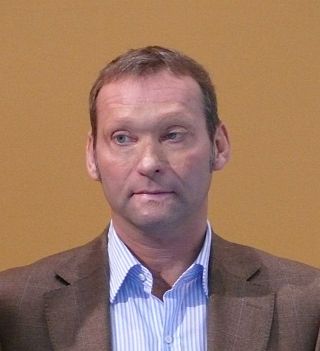
Nils-Kristian "Kris" Nissen is a retired Danish auto racing driver. For several years he was Volkswagen's motorsport director. Since the summer of 2013 he has had a career change and is currently owner and temporary manager of a Danish campingsite called Enderupskov in Southern Jutland.
Superbug is a West German children's comedy film series released between 1971 and 1978, each concerning the adventures of a sentient Volkswagen Beetle and his driver companion. The eponymous film series, and its protagonist, is essentially similar to Disney's Herbie the Love Bug franchise which also concerned the exploits of a seemingly intelligent car, but unlike Herbie which uses magic to show off anthropomorphism, the Superbug instead uses modern technology to display signs of sentience. The Superbug series appeared to be an attempt by director and main actor Rudolf Zehetgruber to bring the "Love Bug" concept to Germany, where the Beetle originated, while giving it the flair of James Bond's gadget-equipped vehicles. The main human character is named Jimmy Bondi. In the first film, which is mainly set in Africa, Bondi inherits a yellow 1963 VW Beetle, which he names "Dudu", the Swahili word for insect or beetle.
Leigh Miller Racing was a team in the Indy Racing League and the IMSA GT Championship created by sportscar driver Leigh Miller in 1994. After competing at the IMSA Supercar Championship in 1993, Miller stepped up to IMSA GT, first with a Porsche 968 and a Porsche 944 Turbo for the GTU, before acquiring two Mazda-developed Kudzu prototypes for the WSC class and setting up his own team.
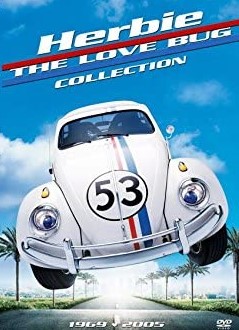
The Herbie franchise consists of American sports adventure comedy theatrical feature films, one television film, a television series, and other multimedia releases. The overall story centers around the titular Herbie, a sentient anthropomorphic 1963 Volkswagen Beetle with a mind of his own and capable of driving himself. The vehicle is oftentimes a legitimate contender, though the underdog contestant in competitive races, but to a greater degree assists his human owners in bettering their lives.


















